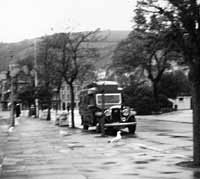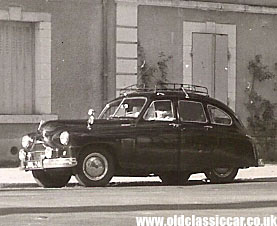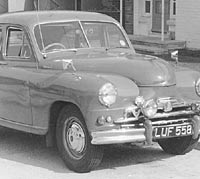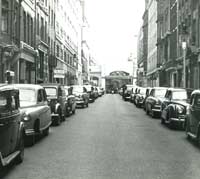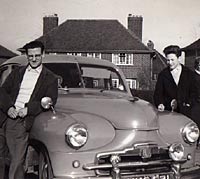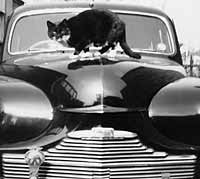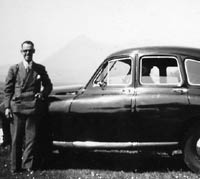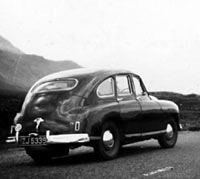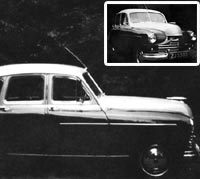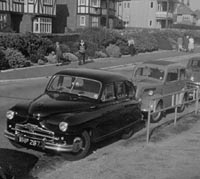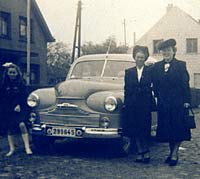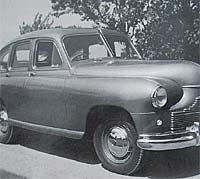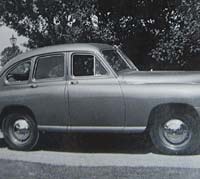| What a stylish way to go on holiday! No queueing up at an airport or having to tow a hulking great caravan about for whoever owned this magnificent pre-war Austin. Daniel kindly sent over scans taken from a number of old photos he owns, and amongst them were various pictures of what are, probably, unique car-based campers. Very eye-catching is the Ford Model AA-based vehicle that features in photos on this page (and which miraculously survives to this day), but no less impressive is this very smartly-turned-out 1930s Austin, presumably that belonged to the same gent. | |
| Alas nothing is known of this vehicle. Who made it? Who owned it? Where these two photos were taken? Which model of Austin is it based upon? All are questions that remain unanswered, unless anyone viewing this page can chip in with extra information? The chrome radiator, and lengthy wheelbase, may give clues as to which chassis was used during the build of this wonderful coachbuilt camper. | |
| I cannot make out the Austin's registration unfortunately. | |
| (Please click the thumbnail to view the full-size image.) | |
| |
| Photograph number two is a little shaky, but may help someone pin down the location for both images, even if it doesn't really add much detail to the Austin. One thing's for sure, it was a damp old day with little evidence of sunshine, or indeed people, in the vicinity. I wonder whether, like the Ford AA, this homely old Austin survived? | |
|
Classic Motor Mag
Friday, May 24, 2019
1930s Austin campervan.
Photographs of a Standard Vanguard Phase
| Source - http://www.oldclassiccar.co.uk/vanguard.htm | Firstly, a Standard Vanguard seen parked in France, with a period roofrack fitted on top. | ||||||||||||
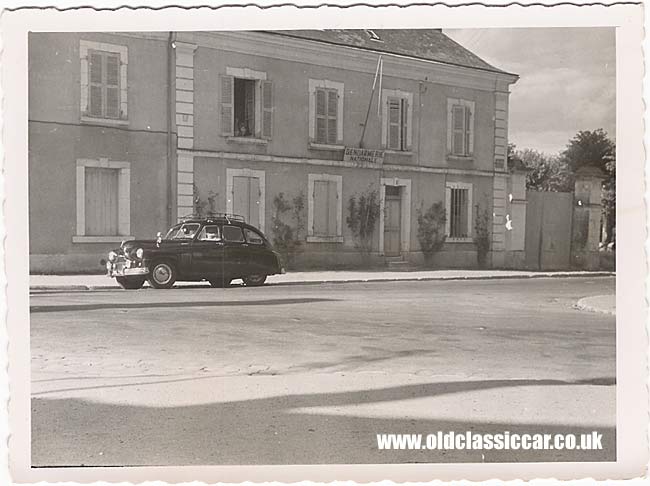
| |||||||||||||
Quite why this black Vanguard is photographed outside a Gendarmerie
Nationale (police station) is anyone's guess, although judging by all
the closed shutters on the ground floor it is either their day off, or
not used too often! The furthermost window has some sturdy bars at the
window, so presumably the local mobsters get thrown in their to cool
off.
What is really weird is that I bought that photo with a collection some time ago, and more recently I purchased another batch, and a photo of what looks like the exact same Standard Vanguard was included, and now shown below. Everything seems to match - roof rack, extra lamps including one fitted to the driver's screen pillar, and even the small part of registration plate that is visible, seems to be the same. The style of photograph, with the crinkly edge, also matched the first photograph. | |||||||||||||
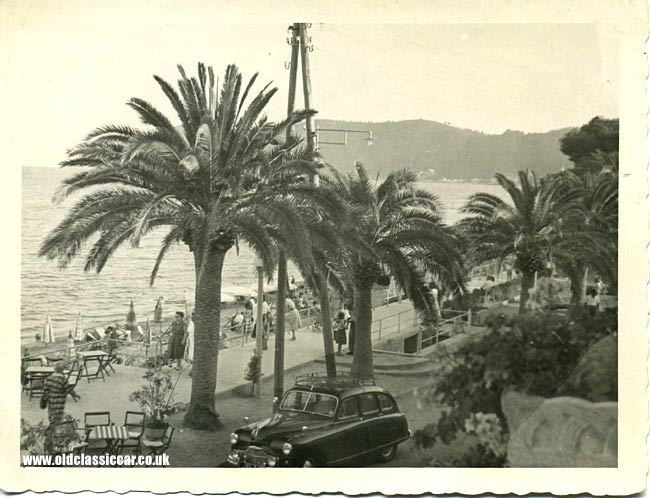
| |||||||||||||
Background to the Vanguard Phase 1.The Phase 1 first saw light of day in 1947, just two years after WW2. Its distinctive styling echoed shades of American design thinking, with its swooping tail and front end chromework. Standards were not yet using monocoque construction, but other elements of the car's design were up-to-date, including a fully synchromesh 'box and hydraulic braking system (rivals such as the A40 from Austin were still hydro-mechanical at the time). The replacement Phase 2 Vanguard came along in '52 and had a more conventional 3 box saloon body (there is also a publicity photo of a Phase 2 here). | |||||||||||||
| Estate & light commercial versions of the Vanguard were also available, again powered by the 2088cc engine. A diesel-powered car was also introduced. | |||||||||||||
2. Another Phase 1 Vanguard, this time in New Zealand.Hans sent me some old photographs, including this one that shows an early (1952) Vanguard parked alongside an old caravan: "This pic is of my wife's grandfather's 1952 Vanguard. He was a mechanic for the local Vanguard agents, and bought the car when it was just a year old off a customer. He kept it right through to the early 70's, and replaced it with a Herald. The caravan was also his, and my wife and I actually used this for our honeymoon." | |||||||||||||
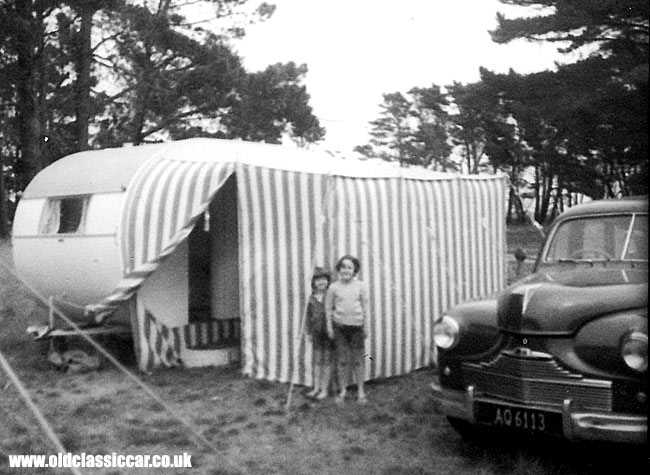
| |||||||||||||
3. Phase 1 Standard Vanguard reg. JTR 467.David emailed over some great black and white photos, and amongst them were these two cracking images, both showing a "beetleback" Phase 1 Vanguard that his father owned. The photos were taken in 1954. Thanks David :-) | |||||||||||||
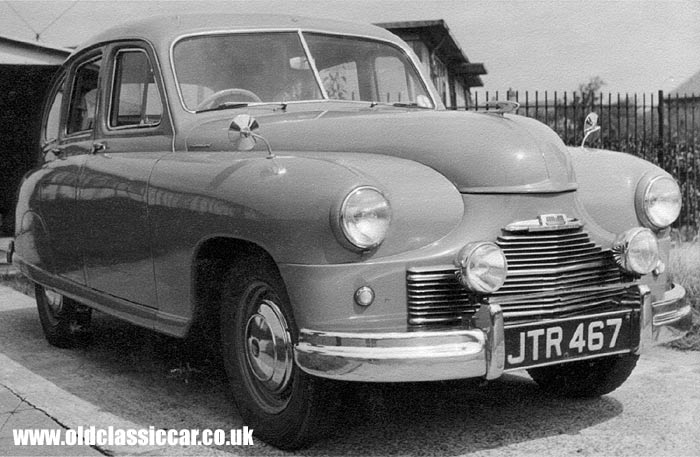
| |||||||||||||

| |||||||||||||
4. Standard Vanguard Phase 1a.The next Vanguard photo to materialise is this period shot of a Phase 1a Vanguard of 1952. The 1a differed from the Phase 1 in a number of ways, most obvious being the revised grille treatment (similar to that seen on the Phase 2 of 1953). The revised bonnet line, and enlarged rear window, were also modifications introduced with the Phase 1a. This one is registered FJN 541, a Southend-on-Sea number, and has been treated to a large pair of auxiliary front lamps, and a roof rack not unlike that shown on the car at the top of this page. Note the radio aerial above the car's windscreen, turned to the passenger side to avoid the material sat on the roof rack. | |||||||||||||
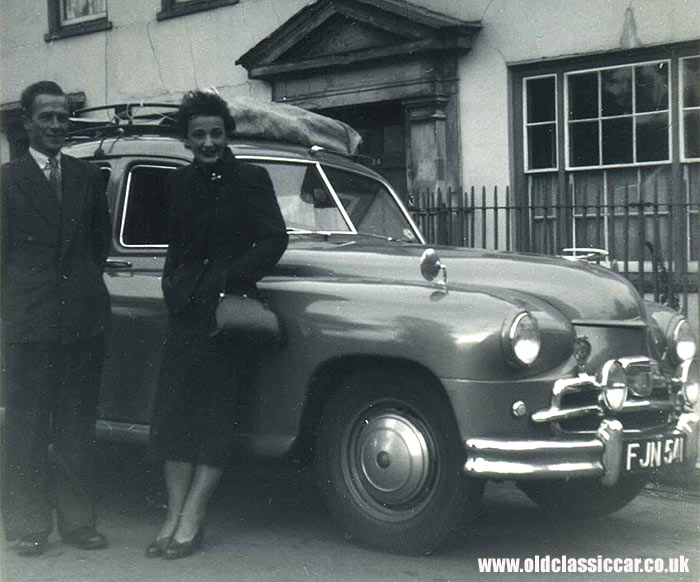
| |||||||||||||
5. A Phase 1 parked near a Ford lorry.The photograph of SXA 730 turned up in June 2009, and like most photos on this page features a Phase 1 Vanguard rather than the 1a. The chrome bumpers and overriders on this car don't look particularly good, so I'm guessing it was a few years old when the photo was taken. In the background is a Thames Trader. | |||||||||||||
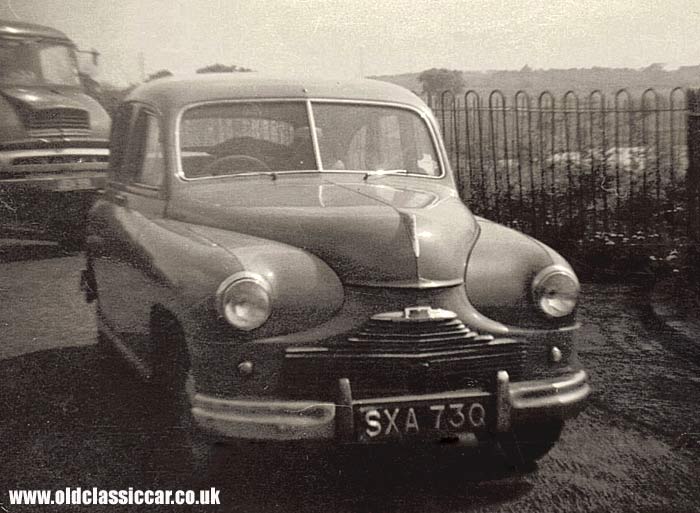
| |||||||||||||
6. A Phase 1 parked in a field.HDU 404 is another Phase 1 Vanguard, this one captured in a field with many other vehicles (cars, motorcycles and sidecars) parked in the distance. A "PRESS" pass is just visible on the passenger side windscreen, but I've not been able to make out the remainder of the writing. Comparing the various Vanguard photographs, it's interesting how many variations of bonnet mascot were fitted - and the car below has none at all! I suspect this is quite an early example, as there are no small sidelights either. The HDU registration code was used in Coventry from 1948 onwards. | |||||||||||||
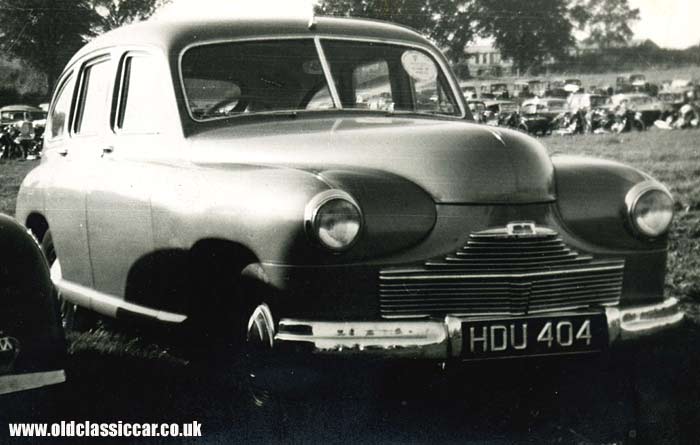
| |||||||||||||
7. A Phase 1a Vanguard.Les kindly emailed over this next shot, featuring a Standard Vanguard in facelifted Phase 1a guise. The registration LUF 558 suggests that this car's early motoring career was spent in and around the streets of Brighton. The owner would appear to have been a keen motorist. Not only does it sport extra lamps and a conversion to flashing indicators (supplementing the original semaphores), but there are also badges for the AA and The Company of Veteran Motorists (or CVM, later known as GEM - Guild of Experienced Motorists). A wireless and aerial have also been installed. | |||||||||||||
| (Please click the thumbnail to view full-size image.) | |||||||||||||
| |||||||||||||
8. Standard parked in London.This next photo, taken in London, features a Phase 1 Vanguard and a real assortment of pre- and post-war classics. The Standard is parked behind an unidentified pre-war car, and behind it is a (now-scarce) Bedford PC van. Behind the van is, I think, a Mk1 Consul, and an E-Series Vauxhall. A similar Vauxhall is parked on the opposite side of the road, along with an Austin A40 Somerset, and a 1937/1938 Ford 7W "Ten". | |||||||||||||
| |||||||||||||
9. 1950s suburbia.Gregory posted a number of older photos onto his Facebook page, this being one of them. In it, a light-coloured Phase 1a Vanguard stars, in a typical suburban street of the 1950s. The grille confirms that it's a Phase 1a rather than a 1. Other than the presence of an AA badge, a pair of wing mirrors and a spotlamp, it's in factory-original condition. Great photo, thanks for allowing me to share it here. | |||||||||||||
| |||||||||||||
10. A re-painted (two-tone) Phase 1 Vanguard.My thanks to David Hunt, who hails from Severn Beach, for providing this next batch of Standard Vanguard photographs. The car, registration ZJ 5339, was bought and subsequently modified, by his father, who was very much a hands-on car enthusiast. The first photograph though is of the family cat, Pickles, perched upon the Phase 1's bonnet. The original style of grille is clearly visible here, something that would go on to be altered by David's father, as later photographs will demonstrate. | |||||||||||||
| |||||||||||||
| Here's the proud owner, stood alongside his prized motor-car. | |||||||||||||
| |||||||||||||
| A rear three-quarter view of the car, note the GB badge affixed to one of the rear bumper overriders. | |||||||||||||
| |||||||||||||
| David's father was a plumber and decorator by trade, but could turn his hand to many practical projects. Apparently he always re-sprayed the cars he owned, the Vanguard included. Firstly, he re-sprayed it in a two-tone colour scheme, then had much of the brightwork re-chromed, and removed every other horizontal bar in the grille, to aid cleaning and polishing. The finished result is shown below. Thanks for the photos David. | |||||||||||||
| |||||||||||||
| While serving in the RAF, David had chance to drive a number of Vanguard pickups. Photos of these RAF vehicles may be found here. | |||||||||||||
11. A Phase 1a parked in an English street.Keith provided this next photo. In it, his father's Phase 1a Vanguard (MHP 267) is shown parked at the side of a quiet road. This classic example of 1950's family transport shares the roadside with two other stalwarts of the post-war British motoring scene - a Ford 103E Popular (note the period windscreen demister fitted), a car produced throughout the 1950s but with its roots firmly implanted in the pre-war era, and a Morris Oxford MO. | |||||||||||||
| |||||||||||||
12. To Belgium, and an early Phase 1.My thanks to Bruno for this next Vanguard photo. The story behind the car, and the people shown with it, isn't known sadly. The grille confirms that it's a Phase 1 Vanguard, and the addition of two spotlamps, plus a roof-mounted radio aerial, suggest that the owner liked to add a few personal touches to their car. Apparently these LHD, Belgian-market, cars were assembled at the former Imperia Automobiles factory, until Standard built a dedicated factory for the purpose. Very interesting to see, thanks for sending it over Bruno. | |||||||||||||
| |||||||||||||
13. A Phase 1 in July 1949.Mike kindly provided the next brace of Standard Vanguard photographs. He took them in July of 1949. Given that the bulk of production was destined for export at the time, anyone in the UK lucky enough to be able to buy a shiny brand new Phase 1 was fortunate indeed. What a belter. Note the roof-mounted radio aerial above the (split) windscreen, pointing downwards between the two panes of flat glass. Thanks for the photos Mike! | |||||||||||||
| |||||||||||||
| |||||||||||||
| Return to Motoring Photographs Page 2. | |||||||||||||
| An interesting account of a Vanguard subjected to a gruelling trial in the Swiss Alps, to promote the car'srugged and reliable design, can be found on this page in the collectables section. |
"Seeing Britain & the Continent from an Austin".
| Maps published with the endorsement of major motor car companies were not unusual, and still turn up today quite frequently. Examples of early maps can be found on this page. I'd not seen a copy of this touring publication before though, prior to stumbling across the example featured below in a box of random old books recently. Titled "Seeing Britain & the Continent from an Austin", it dates to the early 1930s and was compiled on behalf of the Austin Motor Company by Ed. J. Burrow & Co. Ltd, authored by Alison D. Murray, a seasoned travel writer of the day. |

|
| Inside the cover is an illustrated map showing Wales, and the midlands down to the south of Great Britain, with various towns, cities and other places of note given a mention. Within the rear is a similar drawing showing the north and Scotland. Ireland too is covered within this aged book. |

|
| As more and more people invested in a private car for the first time during the 1920s and 1930s, interest in destinations within a comfortable day's driving distance increased. More adventurous souls would plan a motoring holiday that took in much of the UK, or one that involved a lengthy road trip to distant lands that required a basic grasp of a foreign language. With this in mind, the clever people at Austin came up with "Seeing Britain & the Continent from an Austin". |
| Motoring organisations such as the Automobile Association (AA) and the Royal Automobile Club (RAC) would also provide their respective members with specific route itinaries on request. An example issued by the Michelin tyre company in the 1920s can be found here, while an RAC publication from the 1930s that describes a route in North Wales is on this page. In the days before the internet, motorists keen to explore the country relied upon services such as this, and advice given in print magazines and books. Nowadays everyone has the information at their fingertips, but do many people just go out for a drive, just for the sake of exploring the country? |
Introduction from Sir Herbert Austin KBE.Owner and founder of the company, Sir (later Lord) Herbert Austin, provided an introduction to his company's book: |
| "The following pages in this little book have been written with a definite purpose: firstly, to create an interest in "spying out" the thousands of beauty spots in our native land; secondly, to arrange an up-to-date series of short tours and journeys within defined areas; and thirdly, to attempt to create a feeling of confidence between the reader and the manufacturers of a car whose products can be relied upon to give thorough and complete satisfaction." |
| "In spite of the fact that numerous books have been written on the subject of the places and objects worth seeing in Britain, the number of interesting spots is so large, and approachable from so many angles, that there is still room for others, and I am sure the charming manner in which Mr Alison D. Murray has dealt with the subject will prove of interest and lead to many enjoyable trips in what is often, and rightly so, called "God's Own Country". |
| "After having followed the suggested journeys shown on the maps in each of the districts, new impressions and pleasures can be obtained by changing the direction at the start or crossing over at various points en route. It makes all the difference to see the country with the sun at one's back. Just try the experiment of going out to the west in the morning, especially on a sunny day, and coming back home eastwards in the afternoon or evening. The colours and beauty of the trees and the landscape are altogether different and more wonderful." |
| "And then as to the car, it is only a means of conveyance, of course, but in exploring some of the out-of-the-way spots, far from the "madding crowd", it makes the pleasure of the tour complete to be able to feel that "sense of security" which can only come from the possession of a car built with the definite purpose that it shall be thoroughly reliable. The power to climb with ease any hill you may meet, to stop with security on the steepest incline, and give you all the speed you can reasonably need, are bound up with many other advantages in the possession of an Austin car." |
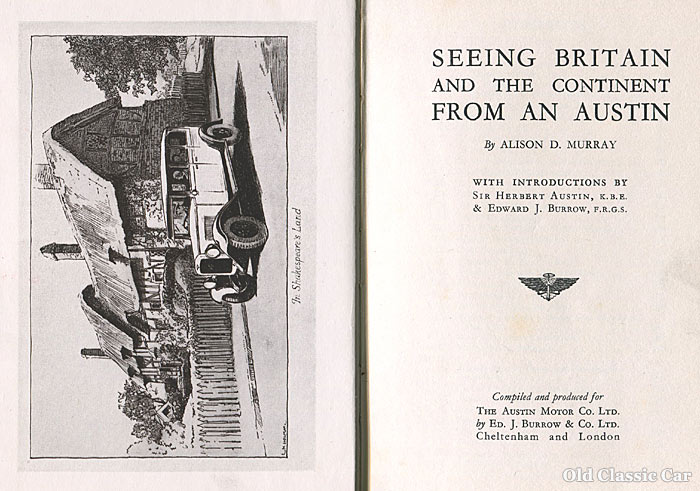
|
Words by the publisher, Edward J. Burrow FRGS.The book's publisher then gives his thoughts on the subject, and sums up the aims of the book in more detail. The opportunity to further the virtues of Austin motor-cars isn't missed: |
| ----- |
| "The Freedom of the Open Road - what a glorious prospect is bound up in that simple phrase and all that it means to the lover of adventure! the freedom that means release from the cares and worries of ordinary life, the broadening of the horizon until the distant purple hills become near neighbours and the white ribbon of the winding road is the pathway to green forest glades, past brimming rivers and through the crowded market-places of quaint old towns, where the crumbling towers of mediaeval castles and cathedrals look down in drowsy contempt on motors drawn up in their long shadows." |
| "This freedom too, with an Austin for company, means an added zest to life in the sense of unaccustomed power - the power which uncannily swings its load of mechanism and human beings blithely up a steep hill without any apparent effort and yet is docile enough to crawl along at walking pace in traffic or where caution is needed. In some mysterious way the power of the sturdy Austin engine links up with the power of the human driver; and nothing is more bracing to the nerves or psychologically inspiring than this sense of being able to annihilate distance and flout the laws of gravity with an ease that is little short of a miracle." |
| "A Wider Circle of Acquaintances The Austin owner, who had taken up motoring for the first time, finds, too, that his circle of acquaintances and his visiting list widen enormously. In the days of Shanks' pony it was impossible to pay visits for more than a mile or so; the bicycle expanded the radius eight or ten miles; but the Austin brings the whole of the country within easy reach of one's door, and laughs at the hills and valleys that lie between us and our once distant friends. A 25-mile run after tea, a round of golf, or a little tennis, or a quiet talk and home again before dark, is an easy venture in the long summer evenings of our English method of cheating the clock - the greatest boon that motorists, who are engaged in making a living during the day, have ever enjoyed." |
| "The Austin as a Domestic Aid Then how many thousands of the fair sex bless their car as they make their daily round of shopping at the nearest convenient market town in their neat little Austin 7, or in the more elegant and roomy 12. As I take my rides abroad I am more and more impressed with the immense difference the small car has made to the busy housewife by bringing her shopping right up to her doorstep; and this is all to the good, for no good domestic manager wishes to shop by telephone if she can avoid it. With the trusty little car she can go to market and personally select her purchases with so little expenditure of time that she will have a good half of the day quite free for the many social engagements of a modern woman's life. So here is a remarkable sidelight of a far-reaching effect on British home life by the use of the convenient Austin." |
| "The Picnic by the Roadside I am inclined to believe that one of the greatest joys of the average small-car owner today is to take wife and family, food, and thermos flasks full of hot tea and coffee, and sally forth for a day's picnic. The Malvern Hills, or the Punch Bowl at Haslemere, and dozens of other similar places are evidence of this natural and healthy desire to get out into the sunshine, amongst the gorse and heather, or in a shady corner of a wood, and, for the n*nce, to revert to the nature-loving habits of our ancestors. Not everyone can afford the time or expense of a tour; but the man or woman who possesses no car misses a great deal of enjoyment, and little realizes how jolly and happy a thing is this weekend run to a convenient spot where the children can romp in the long grass, and father and mother forget for a while the little worries and trials of ordinary life, amidst the hum of bees and the sighing of the breeze." |
| "Touring with an Austin for Company But, apart from these joys of the freedom that comes with the possession of the care-free and foolproof Austin, the true delight of motoring, at least to the owner-driver, is in the carrying-out of a properly arranged tour through the shires of the Old Country, and it is on this aspect that Mr Alison D. Murray has focussed his attention in the present volume. Nothing can excel the delight of planning the tour, with the aid of a good map, such as the Dunlop Atlas or Bartholomew's two miles to the inch. In anticipation one thrills with the expectation of new sensations - the sensations of speed, of effortless power, of the spice of adventure in finding one's way in far-off counties, of the delight that comes from the exploration of one's native land, and actually visiting places one has so often seen in illustrations or even on poster hoardings. For 20 years I have made motor touring my chief hobby, and I can, therefore, give some hints to the novice which will be useful." |
| "Hints to the Novice Firstly, it is best to take the tour in easy stages. If many places of interest are to be inspected, as this should be, it will be best to commence with about 80 miles per day, at about 25 miles per hour, and to gradually increase this as one gets more used to the effort of driving, which a beginner notices a good deal, an old hand not at all. Then it is usually best to base one's stopping places on ascertained comfortable hotels: scenery does not make up for an uncomfortable bed and inferior food: the RAC and AA and the Dunlop Guide all give complete lists of recommended hotels of various grades. Each day at midday a wire should go forward booking up accommodation for the evening, or you may be crowded out. Generally speaking it is best to take the midday meal in the car or by the roadside: this saves time, and motoring does not call for three heavy meals. As to equipment, all supplies can be obtained on the road, but it is not advisable to start a tour with badly worn tyres; if possible, leave these at home for spares, and take new covers, or you may be asking for trouble. In any case be sure you carry your licence with you, and see that your insurance policy covers everything that is necessary. As to the luggage required, and the best way of carrying it - the cases which enclose two or three small trunks, and travel on the luggage grid, are very handy, and keep the dust out of ladies' garments, but it is advisable to see that the hot exhaust does not blow on to, or about, the contents of the grid, as this is apt to seriously affect delicate material." |
| "The Best of Company Now, I will leave you to experience the joy of the open road, with an Austin for company. I envy you the delightful sensation you will experience when, the last strap having been adjusted on the luggage grid, and a final look at the map, the starter rushes the engine into life, the friends standing at the door of the old home wave a cheery good-bye, and the Austin moves out through the gateway into the venture-land of castles and mountains, and placid flowing rivers, lakes, waterfalls, swelling moorlands - to the exploration of dear Old England, our native land. Then, indeed, care-free in the remotest and wildest districts, you will come to appreciate what it means to drive a car that will never fail you, and will bring you back safe and sound in good time, full of gratitude to the Longbridge magicians, who, by their inventive skill, have given you the Austin." |
| ----- |
| The book itself then reveals a good number of worthy destinations, either as suitable excursions for the day-tripper, or the holidaying motorist in search of sites worth visiting as part of a more thorough motor tour. Interesting facts are given, historical and current, along with tips on the routes best chosen to maximise the pleasure of one's visit. Eye-catching landmarks, such as West Gate in Winchester, and the Devil's Chimney near Cheltenham, are just two of the sights to discover. |
| The sights and delights of Ireland are presented in Chapter XXII, this is then followed by an introduction to continental Europe for the Austin-owning reader, with a smattering of destinations given due consideration in one particular route that begins in Calais, then wends its way down through France culminating in Brindisi, Italy. |
| After reading just a few paragraphs of this glovebox-sized book, I can sense the excitement that 1930's motorist must have felt when, with a new Austin tucked away in his or her motorhouse, real consideration was being given to the touring opportunities that their motor-car now offered. |
Source - http://www.oldclassiccar.co.uk/austin-touring.htm
Subscribe to:
Posts (Atom)
1930s Austin campervan.
What a stylish way to go on holiday! No queueing up at an airport or having to tow a hulking great caravan about for whoever owned this ...
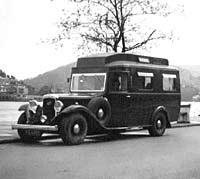
-
What a stylish way to go on holiday! No queueing up at an airport or having to tow a hulking great caravan about for whoever owned this ...
